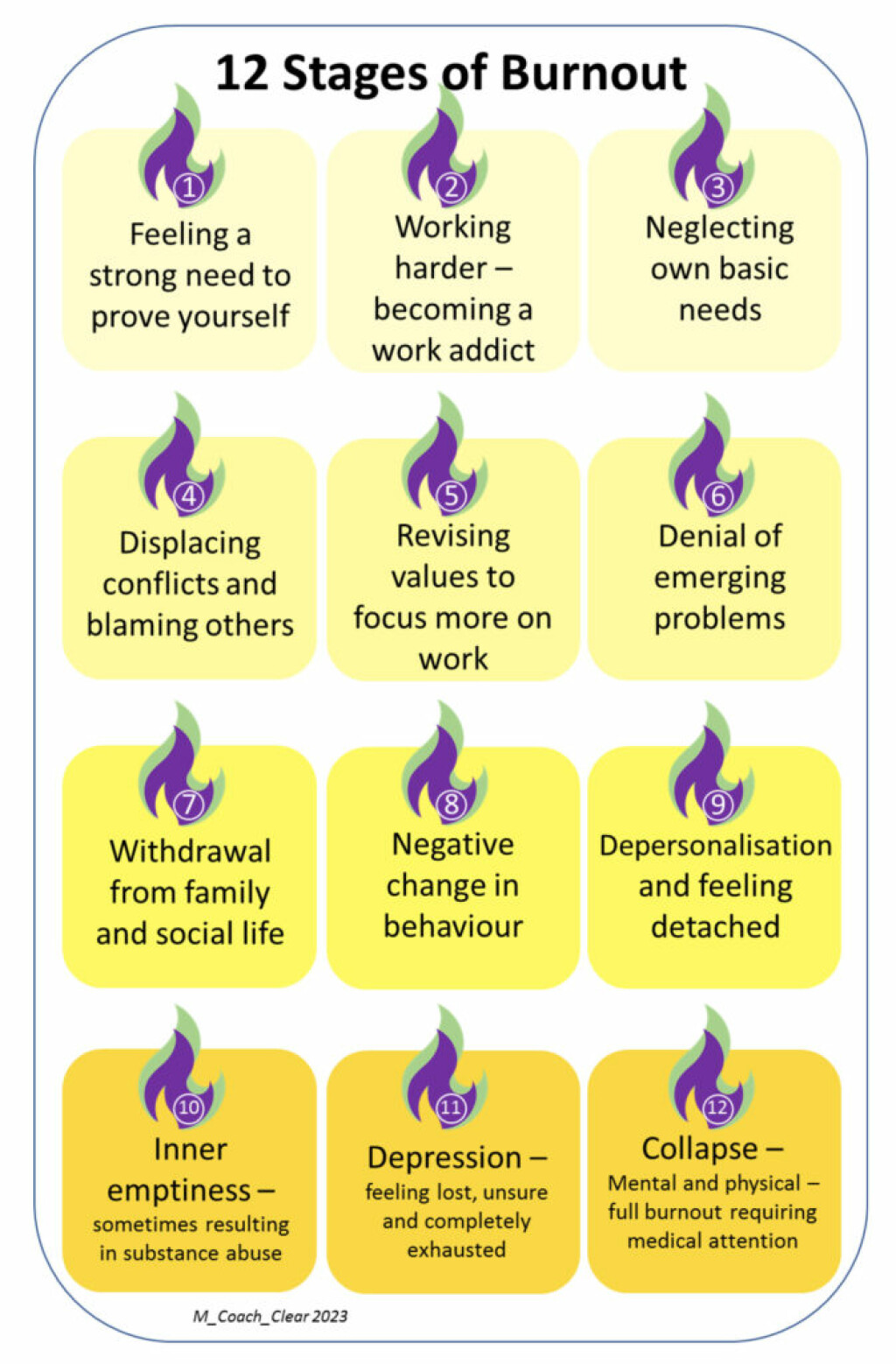Many people find themselves running on or close to empty – working, worrying and juggling a variety of daily demands. Over time, if left unchecked, this can develop beyond just ‘tiredness’ and into deeper physical, emotional and mental exhaustion - often referred to as “Burnout.” It’s important to understand burnout so that we can not only recognise it when but that we can learn to recover from it and prevent it taking over. 
A starting point can be to distinguish between stress and burnout;
Stress is a response to external pressures; it is often short lived and will dissipate once the external stimuli has gone or been resolved. Stress relates to specific challenges or situations in which in that period of time we feel unable to cope with, often with a feeling of tension or sense of urgency to get past in some way. We know that physiologically the nervous system will kick start a ‘stress response’ that will give is the fight or flight activation to either strive towards meeting that demand or avoiding it altogether, and when that situation has passed there is a strong sense of relief.
Whereas burnout is a long term emotional state, that if usually the result of prolonged stress that unresolved gradually brings us to a point of emotional , cognitive and physical exhaustion and depletion. Feeling drained, cynical and disengaged, experiencing burnout leaves us unable to find motivation or sense of satisfaction.
Freudenberger initially introduced the concept of Burnout in the 1970s and then went to develop a stage theory of the process of burnout and how it develops:
- The compulsion to prove oneself; a sense of proving our worth, value and competence. Working towards perceived expectations to be good enough – has ties with habits of perfectionism and high achievers who see self-worth as linked to performance. An “I can’t fail” dialogue, that can lead to over committing and ignoring personal limits even when perceived expectations are unrealistic.
- Working harder; increasing the level and depth of work taken on, trying to live up to the expectations. Saying “yes” when you need could do with saying “no” because you feel that is how you will be valued. Taking on extra tasks and refusing help (or to ask for), unable to delegate (when in a position to do so). Being over-available for others, and working excessive hours. Stress levels might start be noticeably rising in response to the increased work taken on, though in early stages this might be masked by a false sense of productivity due to the high load of tasks.
- Neglecting own needs; keeping work demands front and centre at expense of own necessary self care such as sleep, social activities, meals, etc. For example working into the night regularly after a full day at work and neglecting usual exercise pattern. There is often a sense of guilt and/or anxiety at the idea of taking a break from work in favour of doing something for yourself.
- Displacement of conflicts; this is a form of emotional suppression as inner conflicts that arise from over working – unhappiness, doubt, exhaustion etc – are either ignored or “rationalised”. Irritability can arise but be displaced onto external factors with responses like “I’m fine”.
- Revision of values; work becomes the main focus, friends, family and hobbies become undervalued and neglected. There is an emphasis on how important your job is. We can start to see our job as being synonymous to who we are. Relationships might start to deteriorate as others feel pushed away. Internally there can be a loss of meaning to joy, loss of creativity and empathy.
- Denial of emerging problems; the suppression now merges to a denial. Denial that anything wrong even when you can really feel the tensions building. Your tolerance narrows and irritability and defensive responses increase. When you can admit that things aren’t working there is an external reason given. Physical stress symptoms become more noticeable such as headaches, insomnia and stomach issues.
- Withdrawal; pulling away from social contact and emotional connections, feelings of isolation may be starting to increase. You work on “auto pilot” mode, trying to conserve energy by avoiding people and demands, but inside a feeling of loneliness and disconnection starts to grow.

- Obvious behavioural changes; by now others can see you are struggling. There are clear changes that are visible on the outside (though you may be unaware of what others can see). Your mood is consistently not what it was, your sense of humour has left, you are detached, performance is starting to dip, and there are misunderstandings between yourself and others.
- Depersonalisation; a sense of identity has now started to erode, people often report the sensation of watching their own life play out as if an observer. There is a cynicism and sense of indifference, a lost sense of “who am I anymore?” The numbness starts to lead to an emotional exhaustion.
- Inner emptiness; feeling hollow, anxious or desperate. There is a void, work is no longer fulfilling (remember that initial sense of self at the earlier stages) and everything else has lost meaning. That fear of failure that might have initially been a motivating factor is now overwhelming and heavy, leading to feelings of anxiety. Behaviours such as alcohol, over eating, risk taking and escapism might be used as a ‘coping mechanism’.
- Depression; the emotional side becomes more noticeable for self – overwhelming sadness, hopelessness and worthlessness. There is often huge guilt, low self-esteem and an inability to focus/concentrate. The view point of everything is very pessimistic with questions of “does anything matter anymore”. In some cases we start to see thoughts of suicidal ideation. Once at this stage, it is advised that professional help is sought out (if it hasn’t been already).
- Burnout syndrome (collapse); exhaustion (emotional and physical), feeling at a breaking point or even crisis point. There is a sense of complete collapse – an inability to function and complete disengagement from life around you. It is now definitely time t reach out for help!
Some of these seem to overlap a bit around the middle, and I’m not a huge fan of linear models as I think we can move around between most stages of any process – depending on the demands and circumstances. However, a key point with burnout is that it is a gradual process, it’s a complex mix of feelings and responses, and at various points of that journey the different characteristics and symptoms of full burnout start to emerge.
Burnout is very real, and if we don’t keep an eye out for the signs, then we can push through the stages outlined above without really realising the path we are on.
How can you stay ahead of burnout?
- Boundaries – a therapist’s favourite word! Setting boundaries isn’t week, it reaffirms your worth. Those boundaries might be defined by time (e.g. I log off at 6pm and don’t switch back on until the next morning) or they can be saying no that “please could you do me a favour” request when your workload is already full. Boundaries can be about protecting some time in the week as ‘catch up’ time or admin time.
- Habits – don’t neglect self-care. Self-care isn’t just a bubble bath, it can be making sure you still fit in the things that relax you and bring you joy. That might be a game of tennis once a week, or listening to music, or a routine in the morning, building regular breaks into your day. It’s important to remember that you are allowed to prioritise things for yourself.
- Disconnect to re-charge, not escape – this is another type of boundary. Boundaries are not just for us to practice with others but also ourselves. Doom scrolling is a great example here of disconnecting from the real world but as an escape, there’s rarely any recharging going on there. Do things that give you a break, and fill you back up at the same time.
- Listen to your body! Often people going through burnout notice physical cues – a twinge in the neck, struggle sleeping/waking up, a tenseness, always got the sniffles……that’s your nervous system communicating that it’s regularly being kick started by the stressors building up. By noticing this early on you aren’t forcing your body to scream to get your attention.
- Values – its worth a check in from time to time to see if you are living in line with your values. If you rate spending time with family as 9/10 but recognise it’s something you barely do, then maybe that is a sign that your priorities are a bit off kilter.
Burn out can’t be fixed or avoided by one off changes; it is a continuous practice of balance, self-awareness and compassion. But is important to know that with recovery time, therapeutic support and setting some boundaries, the effects of Burnout can be reversed. If you decided to engage with therapy you could work with the present strains and healthier coping techniques, but you can also unpack the internal elements that may have led to that compulsion to prove yourself in the first place.
out can’t be fixed or avoided by one off changes; it is a continuous practice of balance, self-awareness and compassion. But is important to know that with recovery time, therapeutic support and setting some boundaries, the effects of Burnout can be reversed. If you decided to engage with therapy you could work with the present strains and healthier coping techniques, but you can also unpack the internal elements that may have led to that compulsion to prove yourself in the first place.
Being aware of burnout is the key first step, being aware of the different signs and stages give you the opportunity to spot if you are heading in that direction earlier on. If you recognise that you might be on the path to burnout and feel stuck on how to put the brakes on it just reach out to someone.


 out can’t be fixed or avoided by one off changes; it is a continuous practice of balance, self-awareness and compassion. But is important to know that with recovery time, therapeutic support and setting some boundaries, the effects of Burnout can be reversed. If you decided to engage with therapy you could work with the present strains and healthier coping techniques, but you can also unpack the internal elements that may have led to that compulsion to prove yourself in the first place.
out can’t be fixed or avoided by one off changes; it is a continuous practice of balance, self-awareness and compassion. But is important to know that with recovery time, therapeutic support and setting some boundaries, the effects of Burnout can be reversed. If you decided to engage with therapy you could work with the present strains and healthier coping techniques, but you can also unpack the internal elements that may have led to that compulsion to prove yourself in the first place.